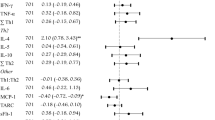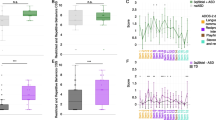Abstract
Between 2006 and 2010, two research-validated instruments, Social Communication Questionnaire (SCQ) and Social Responsiveness Scale (SRS) were filled out online by 4,188 mothers of Autism Spectrum Disorder (ASD) children, aged 4–21, as part of voluntary parental participation in a large web-based registry. Univariate and multivariate linear regression analysis (adjusted for child’s sex, ability to verbalize, categorical IQ score, and fetal growth rate) demonstrated significantly higher SCQ and SRS scores for ASD children of both preterm (<37 weeks) and post-term (>42 weeks) gestational age (GA) compared to ASD children of normal GA, thus indicating that both preterm and post-term children manifest increased ASD symptomatology. Normal GA at birth appears to mitigate the severity of autistic social impairment in ASD children.

Similar content being viewed by others
References
Auyeung, B., Baron-Cohen, S., et al. (2009). Fetal testosterone and autistic traits. British Journal of Psychology, 100(Pt 1), 1–22.
Bauman, M. L. (1996). Brief report: Neuroanatomic observations of the brain in pervasive developmental disorders. Journal of Autism and Developmental Disorders, 26(2), 199–203.
Bauman, M. L., & Kemper, T. L. (2005). Neuroanatomic observations of the brain in autism: A review and future directions. International Journal of Developmental Neuroscience, 23(2–3), 183–187.
Casanova, M. F., El-Baz, A., et al. (2010). A topographic study of minicolumnar core width by lamina comparison between autistic subjects and controls: Possible minicolumnar disruption due to an anatomical element in-common to multiple laminae. Brain Pathology, 20(2), 451–458.
Charman, T., Baird, G., et al. (2007). Efficacy of three screening instruments in the identification of autistic-spectrum disorders. British Journal of Psychiatry, 191, 554–559.
Constantino, J. N., & Gruber, C. P. (2009). Social responsiveness scale. Western Psychological Services: Los Angeles.
Constantino, J. N., Przybeck, T., et al. (2000). Reciprocal social behavior in children with and without pervasive developmental disorders. Journal of Developmental and Behavioral Pediatrics, 21(1), 2–11.
Ehrenstein, V., Pedersen, L., et al. (2007). Postterm delivery and risk for epilepsy in childhood. Pediatrics, 119(3), e554–e561.
Foster, B., & King, B. H. (2003). Asperger syndrome: To be or not to be? Current Opinion in Pediatrics, 15(5), 491–494.
Glasson, E. J., Bower, C., et al. (2004). Perinatal factors and the development of autism: A population study. Archives of General Psychiatry, 61(6), 618–627.
Hallmayer, J., Cleveland, S., et al. (2011). Genetic heritability and shared environmental factors among twin pairs with autism. Archives of General Psychiatry, 68(11), 1095–1102.
Hultman, C. M., Sparen, P., et al. (2002). Perinatal risk factors for infantile autism. Epidemiology, 13(4), 417–423.
Johnson, S., Hollis, C., et al. (2010). Autism spectrum disorders in extremely preterm children. Journal of Pediatrics, 156(4), 525–531. e522.
Lichtenstein, P., Carlstrom, E., et al. (2010). The genetics of autism spectrum disorders and related neuropsychiatric disorders in childhood. American Journal of Psychiatry, 167(11), 1357–1363.
Limperopoulos, C., Bassan, H., et al. (2008). Positive screening for autism in ex-preterm infants: Prevalence and risk factors. Pediatrics, 121(4), 758–765.
Lucia, V. C., Luo, Z., et al. (2006). Reports of birthweight by adolescents and their mothers: Comparing accuracy and identifying correlates. Paediatric and Perinatal Epidemiology, 20(6), 520–527.
Mandell, D. S., Novak, M. M., et al. (2005). Factors associated with age of diagnosis among children with autism spectrum disorders. Pediatrics, 116(6), 1480–1486.
Olesen, A. W., Westergaard, J. G., et al. (2003). Perinatal and maternal complications related to postterm delivery: A national register-based study, 1978–1993. American Journal of Obstetrics and Gynecology, 189(1), 222–227.
Pinto-Martin, J. A., Levy, S. E., et al. (2011). Prevalence of autism spectrum disorder in adolescents born weighing <2000 grams. Pediatrics, 128(5), 883–891.
Rosenberg, R. E., Law, J. K., et al. (2009). Characteristics and concordance of autism spectrum disorders among 277 twin pairs. Archives of Pediatrics and Adolescent Medicine, 163(10), 907–914.
Rutter, M., Bailey, A., et al. (2010). The social communication questionnaire. Western Psychological Services: Los Angeles.
Szatmari, P., Liu, X. Q., et al. (2011). Sex differences in repetitive stereotyped behaviors in autism: Implications for genetic liability. American Journal of Medical Genetics Part B: Neuropsychiatric Genetics, 159B(1), 5–12.
Whitaker, A. H., Van Rossem, R., et al. (1997). Psychiatric outcomes in low-birth-weight children at age 6 years: relation to neonatal cranial ultrasound abnormalities. Archives of General Psychiatry, 54(9), 847–856.
Acknowledgments
This project was funded by the National Institutes of Health (NIH) T32 Training Program in Perinatal Epidemiology at Michigan State University (MSU), grant number 2T32HD046377. We would like to thank the Interactive Autism Network (IAN) of the Kennedy Krieger Institute, Baltimore, MD for providing us with the data for this project.
Author information
Authors and Affiliations
Corresponding author
Rights and permissions
About this article
Cite this article
Movsas, T.Z., Paneth, N. The Effect of Gestational Age on Symptom Severity in Children with Autism Spectrum Disorder. J Autism Dev Disord 42, 2431–2439 (2012). https://doi.org/10.1007/s10803-012-1501-4
Published:
Issue Date:
DOI: https://doi.org/10.1007/s10803-012-1501-4




